Blue Patch on Face Facebook Post Purple Birthmark on Face Facebook Post
A Visual Guide to Birthmarks

Birthmark Basics
1/10
Birthmarks gain attention when there's a media blitz about someone with a visible mark, such as New Orleans Saints quarterback Drew Brees. News reports suggest that he was born with this birthmark on his right cheek, which doctors checked early on and found to be harmless. Folk wisdom calls such babies "touched by an angel," but a doctor's advice is best.

What Is a Birthmark?
2/10
A birthmark is a colored mark on or under the skin that's present at birth or develops shortly after birth.Some birthmarks fade with time; others become more pronounced. Birthmarks may be caused by extra pigment-producing cells in the skin or by blood vessels that do not grow normally. Most birthmarks are painless and harmless. In rare cases, they can cause complications or are associated with other conditions. All birthmarks should be checked by a doctor.
Seen here is former Soviet President Mikhail Gorbachev, who has a port wine stain on his forehead.

Salmon Patches
3/10
Salmon patches are nests of blood vessels that appear as small, pink, flat marks on the skin. They occur in one-third of newborn babies. Salmon patches can appear on the back of the neck ("stork bite"), between the eyes ("angel's kiss"), or on the forehead, nose, upper lip, or eyelids. Some fade as baby grows, but patches on the back of the neck usually don't go away. Salmon patches require no treatment.
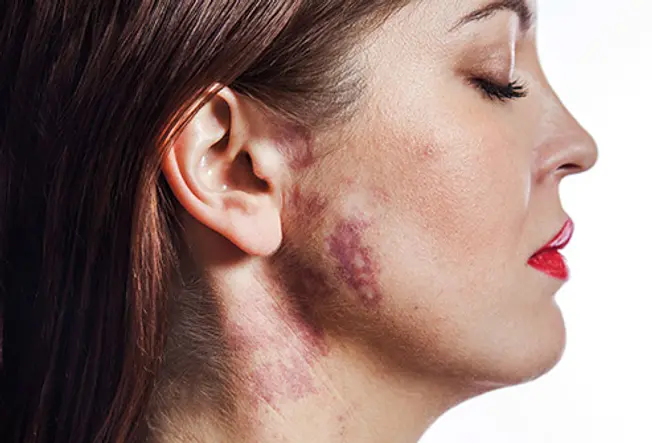
Port Wine Stains
4/10
Port-wine stains are a progressive vascular malformation of the skin, meaning that they're related to the skin's blood vessels. They are made of dilated capillaries that tend to get darker, increase in size and are more suseptible to bleeding with age. The color changes from pink to red to purple as the patient grows, and the lesions may become nodular during adult life. Because port-wine stains show no tendency to shrink, this is a disease with potentially devastating psychological and physical complications. Most medical specialists agree that it is very important to begin treatment as early as possible and to maintain treatment to prevent enlargement and vascular nodules. Treatment includes laser therapy, oral prednisone, skin grafts, and masking makeup.
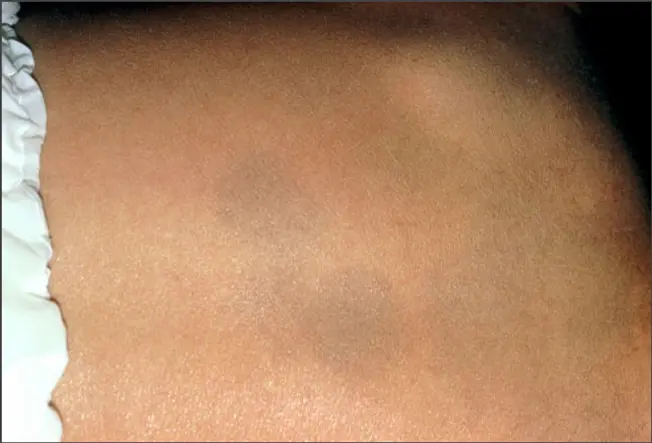
Congenital Melanocytosis
5/10
Congenital melanocytosis are flat, smooth marks that are present from birth. Frequently found on the buttocks or lower back, they're typically blue, but can also be bluish gray, bluish black, or brown. They may resemble a bruise and are most common on darker-skinned babies. Congenital melanocytosis usually fade by school age, but may never disappear entirely. No treatment is needed.

Cafe-Au-Lait Spots
6/10
Cafe-au-lait spots are smooth and oval and range in color from light to medium brown, which is how they got their name, "coffee with milk" in French. They're typically found on the torso, buttocks, and legs. Cafe-au-lait spots may get bigger and darker with age, but are generally not considered a problem. However, having several spots larger than a quarter is linked with neurofibromatosis and the rare McCune-Albright syndrome. Consult a doctor if your child has several spots.

Strawberry Hemangiomas
7/10
Hemangiomas are a collection of small, closely packed blood vessels. Strawberry hemangiomas occur on the surface of the skin, usually on the face, scalp, back, or chest. They may be red or purple and are often raised, with sharp borders. These occur in 2 of every 100 babies born.
Strawberry hemangiomas usually develop a few weeks after birth. They grow rapidly through the first year before disappearing around age 9. Some slight discoloration or puckering of the skin may remain at the site. No treatment is required, but when they develop near the eye or mouth, or in a location that can bleed or become infected, they may need to be treated or removed.
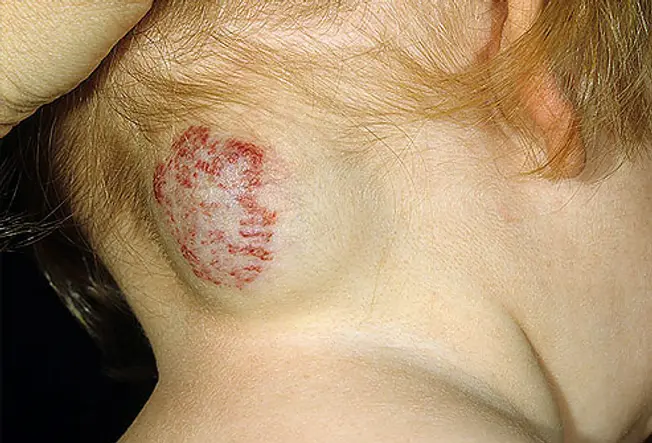
Cavernous Hemangiomas
8/10
Present at birth, deeper cavernous hemangiomas are just under the skin and appear as a bluish spongy mass of tissue filled with blood. If they're deep enough, the overlying skin may look normal. Cavernous hemangiomas typically appear on the head or neck. Most disappear by puberty. A combination of cavernous and strawberry hemangioma can occur.
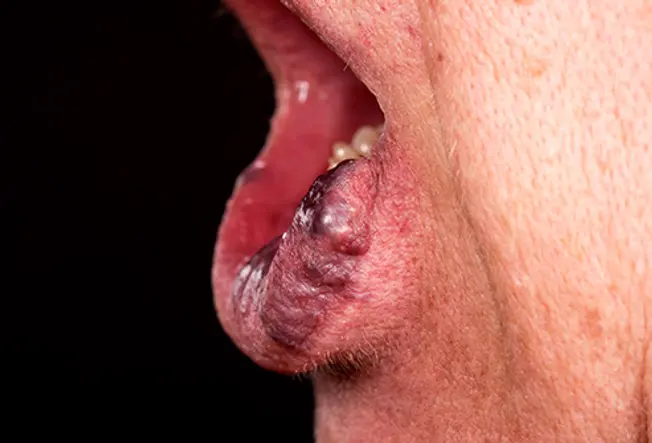
Venous Malformation
9/10
Venous malformations are veins that did not form normally. They are present at birth but sometimes are not visible until later. VMs can look like a growth under the skin or simply resemble a bruise. They typically appear bluish color.
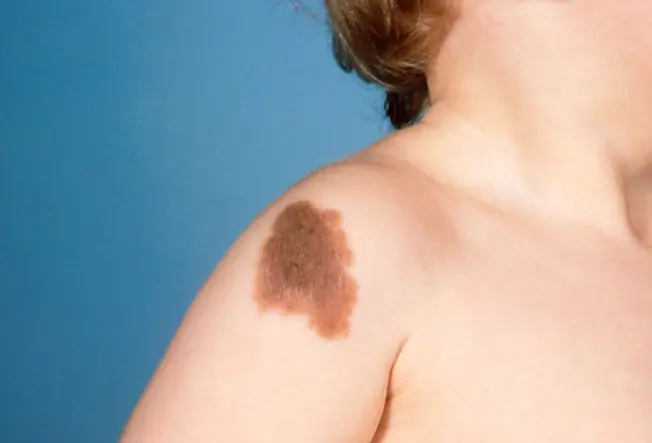
Congenital Nevi
10/10
Congenital nevi are moles that appear at birth. The surface may be flat, raised, or bumpy. These moles can grow anywhere on the body and vary in size from less than an inch to over 8 inches. Congenital nevi occur in 1% of newborns. Most moles are not dangerous. But congenital nevi, especially large ones, have an increased risk of developing into melanoma, the deadliest type of skin cancer. All moles should be monitored for changes.
IMAGES PROVIDED BY: (1) The Palm Beach Post REFERENCES: WebMD Medical Reference: "Your Newborn's Skin and Rashes." Show Sources
(2) Chris Niedenthal / Time & Life Pictures / Getty Images
(3) Biophoto Associates / Photo Researchers, Inc.
(4) Khosrork / Getty Images
(5) SPL / Photo Researchers, Inc.
(6) Copyright © 2007 Interactive Medical Media LLC, All rights reserved.
(7) Dr P. Marazzi / Photo Researchers, Inc.
(8) Copyright © 2007 Interactive Medical Media LLC, All rights reserved.
(9) MID ESSEX HOSPITAL SERVICES NHS TRUST / Science Source
(10) Copyright © Bart's Medical Library / Phototake -- All rights reserved.
WebMD Medical Reference: "Skin Conditions: Pigmented Birthmarks."
WebMD Medical Reference from Healthwise: "Birthmarks -– Topic Overview."
MedlinePlus Medical Encyclopedia: "Birthmarks – Pigmented."
WebMD Medical Reference from Healthwise: "Skin Changes -– Topic Overview."
WebMD Medical Reference provided in collaboration with the Cleveland Clinic: "Skin Conditions: Moles, Freckles and Skin Tags."
WebMD Medical Reference provided in collaboration with the Cleveland Clinic: "Skin Conditions: Red Birthmarks."
MedlinePlus Medical Encyclopedia: "Port Wine Stain."
WebMD Medical Reference: "Cosmetic Procedures: Birthmarks and Other Abnormal Skin Pigmentation."
MedlinePlus Medical Encyclopedia: "Birthmarks –– Red."
American Academy of Dermatology: "Vascular Birthmarks."
KidsHealth: "What's a Birthmark?"
WebMD Medical Reference from the National Organization for Rare Disorders: "Cavernous Malformation."
Vascular Birthmarks Foundation: "Venous Malformation Information."
eMedicine from WebMD: "Vascular, Venous Malformations."
WebMD Public Information from the U.S. National Institutes of Health: "What You Need to Know About Melanoma."
Children's Specialists of San Diego website: "Congenital Pigmented Moles (Congenital Nevi).
New York Times: "Congenital Nevus On the Abdomen."
Dr. Green website: "Hemangioma."
KidsHealth.org: "Port-Wine Stains."
HealthyChildren.org: "Your Newborn's Skin: Birthmarks & Rashes."
HealthyChildren.org: "Birthmarks & Hemangiomas."
American Academy of Dermatology: "Red, white, and brown: Defining characteristics of common birthmarks will determine type and timing of treatment."
American Academy of Dermatology
National Library of Medicine
Children's Hospital of Philadelphia
Seattle Children's Hospital
Johns Hopkins Medicine
Source: https://www.webmd.com/skin-problems-and-treatments/ss/slideshow-birthmarks
0 Response to "Blue Patch on Face Facebook Post Purple Birthmark on Face Facebook Post"
Postar um comentário